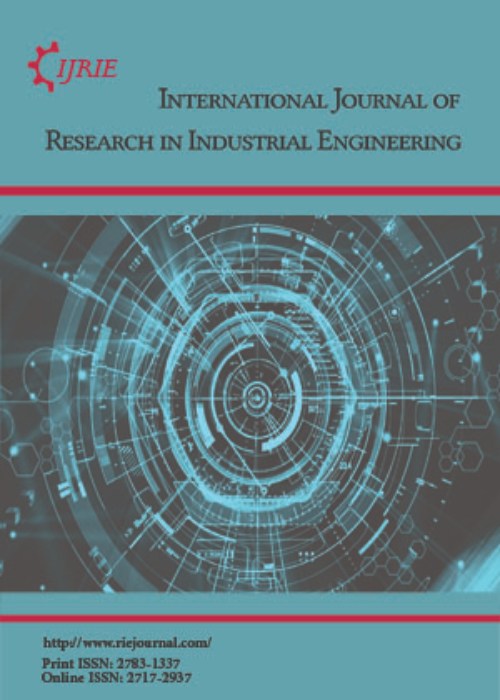فهرست مطالب
International Journal of Research in Industrial Engineering
Volume:3 Issue: 4, Autumn 2014
- تاریخ انتشار: 1393/09/10
- تعداد عناوین: 5
-
Pages 1-12Various procedures, methods, constraints and objectives are studied in a flow shop problem during the past decades. In order to adapt the problem to the reality form, its parameters are considered as a fuzzy model. In this problem, we consider the processing time as the trapezoidal fuzzy numbers. The purpose of this problem is to find an optimum sequence in a way that the makespan or the completing time of jobs to be minimized. In order to solve this problem, in this paper, the Random-Elitist Genetic Algorithm (REGA) is presented in this regard. Observing the performance and the efficiency of this algorithm, we code it by the VBA and compare with the other results. We first test the performance of different crossover operators for our algorithm. Next, using a specific example, we examine the performance of our algorithm. The results indicated that due to very good searching; this algorithm has the good performance in finding the optimal solution and reaching the optimum solution in a very short time.Keywords: Enterprise Resource Planning selection, Threeparameter interval grey numbers, AHP, Shannon Entropy, Three-parameter grey interval incidence degree
-
Pages 13-20
The data envelopment analysis (DEA) is a mathematical programming technique, which is used for evaluating relative efficiency of decision making units (DMUs). However, the DEA does not provide more information about the efficient DMUs. Recently, some researchers have been carried out in the background of using DEA models to generate local weights of alternatives from pairwise comparison matrices used in the analytic hierarchy process (AHP). In this paper, an application of a common set of weights is used for determining priorities in the AHP. First, we determine DEA efficient alternatives as DMUs. Then, these alternatives are ranked according to the efficiency score weighted by the common set of weights in the AHP. This application is applied successfully and the result is valid and assured. A numerical example is utilized to illustrate the capability of this procedure.
Keywords: Data Envelopment Analysis, Decision Making Units, Analytic Hierarchy Process, Common set of weights -
Pages 21-40
One of the major problems in organizations is resource limitation, so the main goal of each union is to maximize the usage of their recourses and improve its efficiency. Universities as a main body of each countries educational system have an important role in developing a country. Therefore, assessing the efficiency of universities and improving the quality of them are important goals. The method of the data envelopment analysis (DEA) can rank the efficiency while the number of indicators does not exceed the specific amount. But in measurement of the universities’ efficiency, main intention is toward considering a comprehensive set of indicators and in this case discrimination power of the DEA method decreases and its results are unacceptable. In this study, we present a combined model of the joint multiple layer DEA (MLDEA) model and weight restrictions method in order to try to eliminate the weakness of the mentioned method. Educational units of ShahidBahonar University of Kerman are evaluated and ranked as a case study. Empirical results shows the efficiency of presented model based on discrimination power, weight allocating and possibility of implementing this model in evaluating the function of activities, which have many indicators along with hierarchical structure.
Keywords: Data Envelopment Analysis, Multiple Layer DEA, Weight restrictions, Analytic Hierarchy Process, Performance Evaluation -
Pages 41-56
Selecting the most appropriate and optimal facility location for a new organization or expansion of an existing location is an important strategic issue. The location, which results in higher economic benefits through increased productivity and good distribution network, is the best location. It is necessary to compare the performance characteristics in a decisive way when a choice is to be made from among several alternative facility locations. While the facility location selection problem includes multiple conflicting criteria and a finite set of potential candidate alternatives, different multi-criteria decision making (MCDM) methods can be effectively applied to solve such type of problem. In this paper, we apply three MCDM methods on a facility location selection problem and their relative ranking performances are compared. Because of disagreement in the ranks obtained by the three different MCDM methods, a final ranking method based on REGIME is also proposed to facilitate the decision making process. Then, the results of this study are compared by the results of the same study.
Keywords: Facility location, mcdm methods, REGIME, Aras, COPRAS, TOPSIS -
Pages 57-69Risk is a destructive phenomenon, which is an integral part of any business. Process mining is a form of a business process analysis based on the recorded process data by information systems, whose its aim is to discover process, control, data, organizational and social structures from event logs. A process mining project methodology (PMPM) is considered as especially useful in the process mining project, which a comprehensive methodology that can be used as an efficient and effective approach for applying process mining in practice. This methodology made us sure that all important activities are performed and prevented of redundant work. This paper utilizes the PMPM for risk reduction to increase the organization agility against competitors and obtain the more market share. Evaluating the case study results with trace alignment method confirms expert confirmations. Trace alignment shows interesting patterns and provide better insight on process executions.Keywords: Process mining, risk, Process Mining Project Methodology, case study


